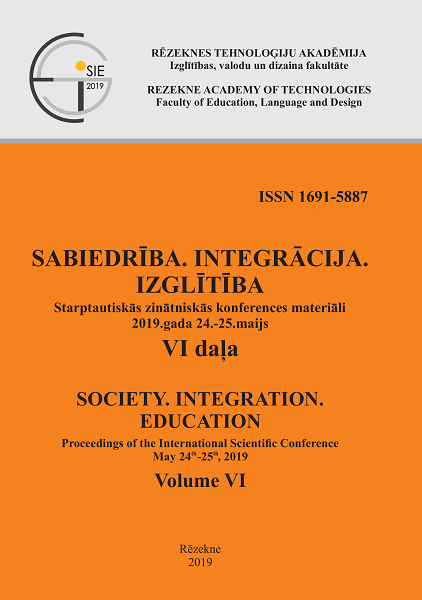ORGANIZATIONAL DESIGN, INTERNAL COLLABORATION AND PERFORMANCE: AN EMPIRICAL ASSESSMENT IN LATVIA
DOI:
https://doi.org/10.17770/sie2019vol6.3974Keywords:
collaboration, knowledge sharing, organisational design, structure, trustAbstract
We live in the time of transformations and in response to environmental challenges, traditional forms of organizational designs are changing towards more networked ones. Human resource practitioners claim that ‘Organization of the future’ requires freedom to act, flexible working practices, outcome-based performance management, and high-trust working relationships, however, there is limited empirical attention directed to the elements of organizational structures, and organizational design aspects have not been explicitly addressed. This research aims to identify which organizational design mechanisms facilitate collaboration within organizations and positively contribute to organizational performance. The quantitative study uses data from a structured survey of Latvian organizations. The research findings provide empirical evidence of the positive impact of decentralization, outcome-based performance management and internal trust on collaboration within the organizational boundaries and performance measured as customer satisfaction. Assessing differences between organisations it was found that internal trust appears to be even more important collaboration ensuring factor for large organizations than for smaller ones. Research results show that managers should establish internal trust-based relationships within their organizations since the effect of trust on collaboration could not be overestimated.
References
Arora, A., Belenzon, S. & Rios, L. A., (2014). Make, buy, organize: the interplay between research, external knowledge, and firm structure. Strategic Management Journal, 35(3), 317-337. DOI: https://doi.org/10.1002/smj.2098
Burke, M. E., (2003). Philosophical and theoretical perspectives of organizational structures as information processing systems. Journal of Documentation, 59(2),131-142. Retrieved from https://scholar.google.co.uk/citations?user=3TtWCbkAAAAJ&hl=en
Busi, M. & Bitici, U. S., (2006). Collaborative Performance Management: Present Gaps and Future Research. Journal of Performance and Productivity Management, 55(1),7-25. DOI: https://doi.org/10.1108/17410400610635471
Chalkiti, K., (2012). Knowledge sharing in dynamic labor environments: insights from Australia. International Journal of Hospitality Management, 24(4), 522-541. DOI: https://doi.org/10.1108/09596111211226806
Christie, A., Joye, M. & Watts, R., (2003). Decentralization of the firm: theory and evidence. Journal of Corporate Finance, 9(2), 3-36. Retrieved from http://www.wiwi.uni-bonn.de/kraehmer/Lehre/SeminarSS09/Papiere/Christie_et_al_Decentralization_theory_evidence.pdf
CIPD, (2012). Innovative forms of organizing, London: CIPD.
CIPD, (2017). A guide to organization design approaches, the types of organizational structures, and the factors which influence the choice of organization design.
Retrieved from https://www.cipd.co.uk/knowledge/strategy/organisational-development/design-factsheet
CSB, (2015). Large, medium and small enterprises.
Retrieved from http://www.csb.gov.lv/en/statistikas-temas/termini/large-medium-and-small-enterprises-35202.html
Curado, C., (2006). Organizational learning and organizational design. The Learning Organization, 13(1), 25-48. DOI: https://doi.org/10.1108/09696470610639112
Deloitte Development LLC, (2016). Global Human Capital Trends 2016 The new organization: Different by design, Deloitte University Press.
Deloitte Development LLC, (2017). Rewriting the rules for the digital age: 2017 Deloitte Global Human Capital Trends, Deloitte University Press.
Foss, N. J., Lungggsie, J. & Zahra, S. A., (2013). The role of external knowledge sources and organizational design in the process of opportunity exploitation. Strategic Management Journal, 34(12),1453-1471. DOI: https://doi.org/10.1002/smj.2135
Gebauer, H., Fischer, T. & Fleisch, E., (2010). Exploring the interrelationship among patterns of service strategy changes and organizational design elements. Journal of Service management, 21(1),103-129. DOI: https://doi.org/10.1108/09564231011025137
Hair, J. F. & Ringle, C. M., (2011). PLS-SEM; indeed a silver Bullet. Journal of Marketing Theory and Practice, 19(2), 139-151. DOI: https://doi.org/10.2753/MTP1069-6679190202
Hernaus, T., Vuksic, V. B. & Stemberger, M. I., (2016). How to go from strategy to results? Institutionalizing BPM governance within organizations. Business Process Management Journal, 22(3),173-195. DOI: https://doi.org/10.1108/BPMJ-03-2015-0031
Hunter, J., (2002). Improving organizational performance through the use of effective elements of organization. Leadership in Health Services, 15(3), 12-21. DOI: https://doi.org/10.1108/13660750210441893
Kates, A. & Gailbraith, J. R., (2008). Designing Your Organization: Using the STAR Model to Solve Critical design Challemges. NJ: Jossey-Boss.
Keith, P. & Dotsika, F., (2007). Knowledge sharing: developing from within. The Learning Organization, 14(5), 395-406. DOI: https://doi.org/10.1108/09696470710762628
Koch, N., 2015. Common method bias PLS-SEM; A full collinearity assessment approach. International Journal of e-Collaboration, 11(4), 1-10. DOI:10.4018/ijec.2015100101
Kohlbacher, M. & Reijers, H. A., (2013). The effects of process-oriented organizational design on firm performance. Business Process Management Journal, 19(2), 245-262. DOI: https://doi.org/10.1108/14637151311308303
Kretschmer, T. & Puranam, P., (2008). Integration through incentives within differentiated organizations. Organization Science, 19(6), 860-875. Retrieved from https://pdfs.semanticscholar.org/741e/64d87e132fcd5b5209561ba46c6e17f02281.pdf
Lursoft, (2017). NACE classificatory.
Retrieved from https://nace.lursoft.lv/?vr=3&old=0&v=en&o=&q=
Mahmoudsalehi, M., Maradkhannejad, R. & Safari, K., (2012). How knowledge management is affected by organizational structure. The Learning Organization, 19(6), 518-528. DOI: https://doi.org/10.1108/09696471211266974
Marsh, C. u.c., (2009). Integrated Organizational Design: The new Strategic priority for HR Directors, Lancaster: center for Performance-led HR; Lancaster University.
Martin-Perez, V., Martin-Cruz, N. & Estrada-Vaquero, I., (2012). The influence of organizational design on knowledge transfer. Journal of Knowledge Management, 16(3), 418-434. DOI: https://doi.org/10.1108/13673271211238742
Mason, J. & Lefrere, P., (2003). Trust, Collaboration, e-Learning and Organizational Transformation. International Journal of Training and Development, 7(4), 259-270. DOI: https://doi.org/10.1046/j.1360-3736.2003.00185.x
Nikolenko, A. & Kleiner, B. H., (1996). Global trends in organizational design. Work study, 45(7), 23-25. DOI: http://dx.doi.org/10.1108/00438029610150966
Pereira-Molinier, J. u.c., (2016). Organizational design, quality management and competitive advantage in hotels. International journal of Contemporary Hospitality Management, 28(4), 762-784. DOI: https://doi.org/10.1108/IJCHM-10-2014-0545
Ringle, C. M., Wende, S. & Becker, j. M., (2014). SmartPLS. Hamburg: Smart-PLS.
Robbins, S., 1990. Organization theory: structure, design, and applications. International ed. Engelwood Cliffs: Prentice-Hall.
Satell, G., (2017). What Makes an Organization “Networked”?, Harvard Business Review, June 08.
Stan, M. & Puranam, P., (2017). Organizational Adaptation to interdependence Shifts: The role of Integrator Structures. Strategic Management Journal, 38(5), 1041-1061. DOI: https://doi.org/10.1002/smj.2546
The Economist Intelligence Unit, (2008). The role of trust in business collaboration, London: The Economist.
Tsung-Hsien, T., (2013). How expected benefit and trust influence knowledge sharing. Industrial management & Data Systems, 113(4), 506-522. DOI: https://doi.org/10.1108/02635571311322766
Vissher, K. & Visscher-Voerman, I., (2010). Organizational design approaches in management consulting. Management Decision, 48(5), 713-733. DOI: https://doi.org/10.1108/02517471080000701
Weigelt, C. & Miller, D. J., (2013). Implications of internal organization structure for firm boundaries. Strategic Management Journal, 34(12), 1411-1435. DOI: https://doi.org/10.1002/smj.2074
Zehra, A. B., (2014). New Organization structures: virtual organizations. International Journal of Engineering and Applied Sciences, 6(2), 18-27. Retrieved from http://eaas-journal.org/survey/userfiles/files/v6i203%20VIRTUAL%20ORGANIZATIONS.pdf






